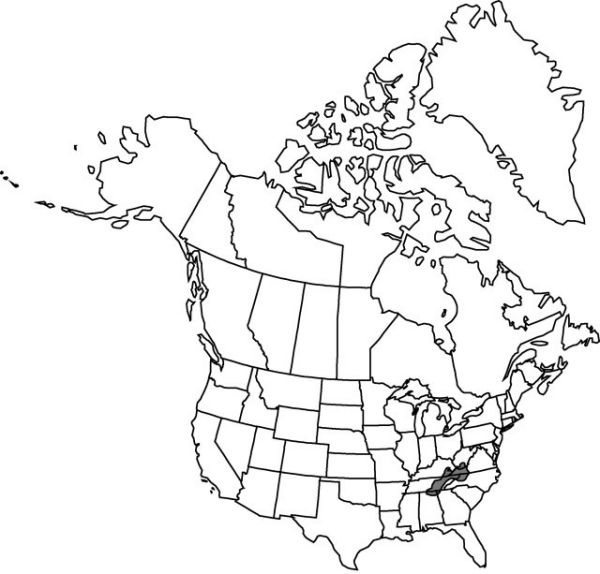Difference between revisions of "Trillium sulcatum"
Brittonia 36: 27, figs. 1–4. 1984.
FNA>Volume Importer |
imported>Volume Importer |
||
| (6 intermediate revisions by 2 users not shown) | |||
| Line 8: | Line 8: | ||
}} | }} | ||
|common_names=Southern red trillium;Barksdale trillium | |common_names=Southern red trillium;Barksdale trillium | ||
| + | |special_status={{Treatment/ID/Special_status | ||
| + | |code=E | ||
| + | |label=Endemic | ||
| + | }} | ||
|basionyms= | |basionyms= | ||
|synonyms= | |synonyms= | ||
| Line 24: | Line 28: | ||
|elevation=300–400 m | |elevation=300–400 m | ||
|distribution=Ala.;Ga.;Ky.;N.C.;Tenn.;Va.;W.Va. | |distribution=Ala.;Ga.;Ky.;N.C.;Tenn.;Va.;W.Va. | ||
| − | |discussion=<p>Trillium sulcatum is present mainly on the Cumberland Plateau and is absent from the Great Smoky Mountains and the southern Blue Ridge Mountains.</p><!-- | + | |discussion=<p><i>Trillium sulcatum</i> is present mainly on the Cumberland Plateau and is absent from the Great Smoky Mountains and the southern Blue Ridge Mountains.</p><!-- |
| − | --><p>T. S. Patrick (1984) described Trillium sulcatum flowers as “relatively small and turned downward.” This is true of plants from the type locality; however, in most plants of the Cumberland Plateau, the flowers are quite large and flattened, and the petals are recurved distally and face outward.</p> | + | --><p>T. S. Patrick (1984) described <i>Trillium sulcatum</i> flowers as “relatively small and turned downward.” This is true of plants from the type locality; however, in most plants of the Cumberland Plateau, the flowers are quite large and flattened, and the petals are recurved distally and face outward.</p> |
|tables= | |tables= | ||
|references={{Treatment/Reference | |references={{Treatment/Reference | ||
| Line 37: | Line 41: | ||
-->{{#Taxon: | -->{{#Taxon: | ||
name=Trillium sulcatum | name=Trillium sulcatum | ||
| − | |||
|authority=T. S. Patrick | |authority=T. S. Patrick | ||
|rank=species | |rank=species | ||
| Line 51: | Line 54: | ||
|publication title=Brittonia | |publication title=Brittonia | ||
|publication year=1984 | |publication year=1984 | ||
| − | |special status= | + | |special status=Endemic |
| − | |source xml=https:// | + | |source xml=https://bitbucket.org/aafc-mbb/fna-data-curation/src/2e0870ddd59836b60bcf96646a41e87ea5a5943a/coarse_grained_fna_xml/V26/V26_115.xml |
|genus=Trillium | |genus=Trillium | ||
|subgenus=Trillium subg. Trillium | |subgenus=Trillium subg. Trillium | ||
Latest revision as of 21:11, 5 November 2020
Rhizomes horizontal–slightly erect, thick, praemorse. Scapes 1–4+, round in cross section, 3–7 dm, 2–2.5 times as long as bract, stout, glabrous. Bracts subsessile; blade obovate to broadly elliptic, 13–20 × 8–22 cm, not glossy, base attenuate, apex acuminate. Flower facing outward at right angle to pedicel, above bracts, odor faintly musty, like fresh fungus; perianth gaping, strongly 3-dimensional; sepals spreading, usually streaked or entirely purplish maroon, occasionally entirely green except on margins, elliptic, 15–38 × 9–15 mm, margins entire, apex strongly sulcate-acuminate; petals carried somewhat forward to recurved-spreading in distal 1/2, usually dark reddish maroon to purplish, rarely cream to soft yellow, pink, white, or 2-colored, heavy-veined, ovate to broadly ovate-overlapping, 1.8–5 × 1–3 cm, heavy-textured, apex acuminate, rarely somewhat sulcate; stamens erect, ± equaling or slightly longer than ovary, 15–18 mm; filaments purple to white, 3–5 mm, slender; anthers straight, purplish to yellow, 5–12 mm, thick, dehiscence introrse; connectives equaling or ± shorter than anther sacs; ovary usually dark purple, globose to flask-shaped, 6-angled, 14–18 mm, broadly attached basally; stigmas prominent, recurved, distinct, purple, not lobed adaxially, basally thickened, gradually tapered, 2–5 mm, fleshy; pedicel usually stiffly erect (rarely almost horizontal above bracts), straight, reflexed ± 90° at tip, 6–11 cm. Fruits red, fragrance of fresh mushrooms, ± globose to pyramidal, 1.5–3 × 1.2–2.8 cm, juicy to pulpy. 2n = 10.
Phenology: Flowering mid spring (Apr–May).
Habitat: Rich mesic woodlands, especially moist north- or east-facing slopes, wooded ledges and stream banks on neutral to slightly acid soil
Elevation: 300–400 m
Distribution

Ala., Ga., Ky., N.C., Tenn., Va., W.Va.
Discussion
Trillium sulcatum is present mainly on the Cumberland Plateau and is absent from the Great Smoky Mountains and the southern Blue Ridge Mountains.
T. S. Patrick (1984) described Trillium sulcatum flowers as “relatively small and turned downward.” This is true of plants from the type locality; however, in most plants of the Cumberland Plateau, the flowers are quite large and flattened, and the petals are recurved distally and face outward.